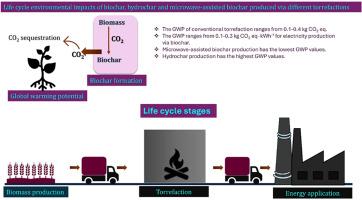A review of comparative life cycle assessment of dry, wet, and microwave torrefaction pathways for sustainable bioenergy systems
IF 16.3
1区 工程技术
Q1 ENERGY & FUELS
引用次数: 0
Abstract
Understanding the lifecycle carbon impacts of different torrefaction methods is critical to advancing sustainable bioenergy solutions. While prior research has explored individual torrefaction pathways, comprehensive comparisons of carbon flows and global warming potential (GWP) across dry (conventional), wet (hydrothermal carbonization), and microwave-assisted torrefaction remain limited. This review compares the life cycle assessment (LCA) results of these torrefaction technologies, focusing on their carbon footprints, GWP per experimental configuration, and net carbon benefits (NCB). Conventional torrefaction exhibits GWP values ranging from 0.1 to 0.4 kg CO2 eq per kg biomass, while electricity generation from torrefied biochar generally ranges between 0.1 and 0.3 kg CO2 eq·kWh−1. Microwave-assisted torrefaction demonstrates the lowest GWP (∼0.110 kg CO2 eq·kWh−1), making it a promising route for producing coal-like solid fuels. Conversely, hydrochar-based electricity from hydrothermal carbonization tends to yield higher GWP. Feedstock type, energy source, process temperature, and LCA boundary conditions influence environmental impacts across torrefaction methods. Among the pathways evaluated, microwave torrefaction offers higher NCB, lower emissions, and greater process efficiency for energy recovery. This review also outlines methodological challenges in LCA harmonization and highlights opportunities for carbon credit validation and policy support toward net-zero biomass energy systems.

可持续生物能源系统中干法、湿法和微波加热途径的比较生命周期评估综述
了解不同热解方法的生命周期碳影响对于推进可持续生物能源解决方案至关重要。虽然之前的研究已经探索了单个碳化途径,但对干法(常规)、湿法(热液碳化)和微波辅助碳化的碳流量和全球变暖潜能值(GWP)的综合比较仍然有限。这篇综述比较了这些热解技术的生命周期评估(LCA)结果,重点关注它们的碳足迹、每个实验配置的GWP和净碳效益(NCB)。传统碳化的GWP值为每千克生物质0.1至0.4千克二氧化碳当量,而碳化生物炭的发电量通常在0.1至0.3千克二氧化碳当量·千瓦时−1之间。微波辅助焙烧显示出最低的GWP (~ 0.110 kg CO2 eq·kWh−1),使其成为生产类煤固体燃料的有前途的途径。相反,水热碳化产生的水力发电往往会产生更高的全球升温潜能值。原料类型、能源、过程温度和LCA边界条件会影响各种焙烧方法对环境的影响。在评估的途径中,微波焙烧具有更高的NCB,更低的排放和更高的能量回收过程效率。本综述还概述了LCA统一的方法挑战,并强调了碳信用验证和对净零生物质能源系统的政策支持的机会。
本文章由计算机程序翻译,如有差异,请以英文原文为准。
求助全文
约1分钟内获得全文
求助全文
来源期刊

Renewable and Sustainable Energy Reviews
工程技术-能源与燃料
CiteScore
31.20
自引率
5.70%
发文量
1055
审稿时长
62 days
期刊介绍:
The mission of Renewable and Sustainable Energy Reviews is to disseminate the most compelling and pertinent critical insights in renewable and sustainable energy, fostering collaboration among the research community, private sector, and policy and decision makers. The journal aims to exchange challenges, solutions, innovative concepts, and technologies, contributing to sustainable development, the transition to a low-carbon future, and the attainment of emissions targets outlined by the United Nations Framework Convention on Climate Change.
Renewable and Sustainable Energy Reviews publishes a diverse range of content, including review papers, original research, case studies, and analyses of new technologies, all featuring a substantial review component such as critique, comparison, or analysis. Introducing a distinctive paper type, Expert Insights, the journal presents commissioned mini-reviews authored by field leaders, addressing topics of significant interest. Case studies undergo consideration only if they showcase the work's applicability to other regions or contribute valuable insights to the broader field of renewable and sustainable energy. Notably, a bibliographic or literature review lacking critical analysis is deemed unsuitable for publication.
 求助内容:
求助内容: 应助结果提醒方式:
应助结果提醒方式:


